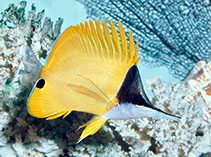| Family: |
Chaetodontidae (Butterflyfishes) |
| Max. size: |
22 cm TL (male/unsexed); max. reported age: 18 years |
| Environment: |
reef-associated; marine; depth range 0 - 145 m, non-migratory |
| Distribution: |
Indo-Pacific: Red Sea and East Africa (Ref. 12484) to the Hawaiian and Easter islands, north to southern Japan, south to Lord Howe Island; throughout Micronesia. Eastern Pacific: southern Baja California, Mexico and from the Revillagigedo and Galapagos Islands (Ref. 5227, 11482). |
| Diagnosis: |
Dorsal spines (total): 12-13; Dorsal soft rays (total): 19-25; Anal spines: 3-3; Anal soft rays: 17-19. Description: Head dorsal black and ventral white silver, body yellow; median fins yellow, anal fin spot black bellow tail base. Snout length 1.6-1.8 in HL. Body depth 1.9-2.4 in SL (Ref. 90102). |
| Biology: |
Common in exposed seaward reefs but also found in lagoon reefs (Ref. 9286). Benthopelagic (Ref. 58302). Solitary or in small groups of up to 5 individuals (Ref. 9286). Adults usually in pairs (Ref. 48636). Feed on a wide variety of animal prey including hydroids, fish eggs, small crustaceans but prefers tube feet of echinoderms, pedicilaria of sea urchins, and polychaete tentacles (Ref. 1602). Oviparous (Ref. 205), monogamous (Ref. 52884). Form pairs during breeding (Ref. 205). Second most important export in Hawaii (Ref. 37816). Minimum depth reported taken from Ref. 128797. |
| IUCN Red List Status: |
Least Concern (LC); Date assessed: 09 October 2009 Ref. (130435)
|
| Threat to humans: |
harmless |
Source and more info: www.fishbase.org. For personal, classroom, and other internal use only. Not for publication.

